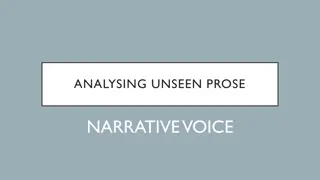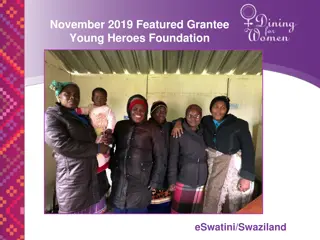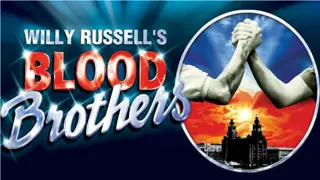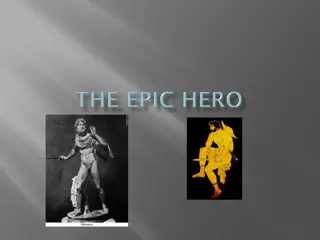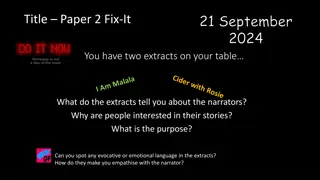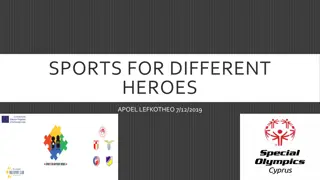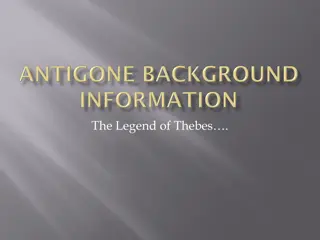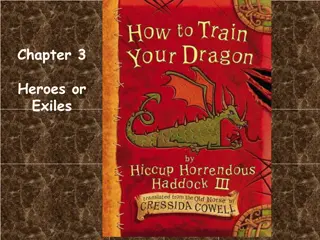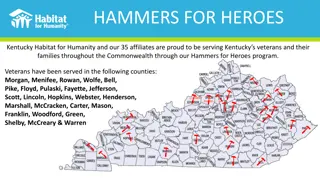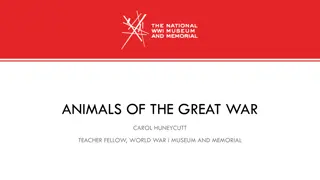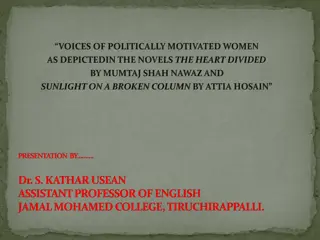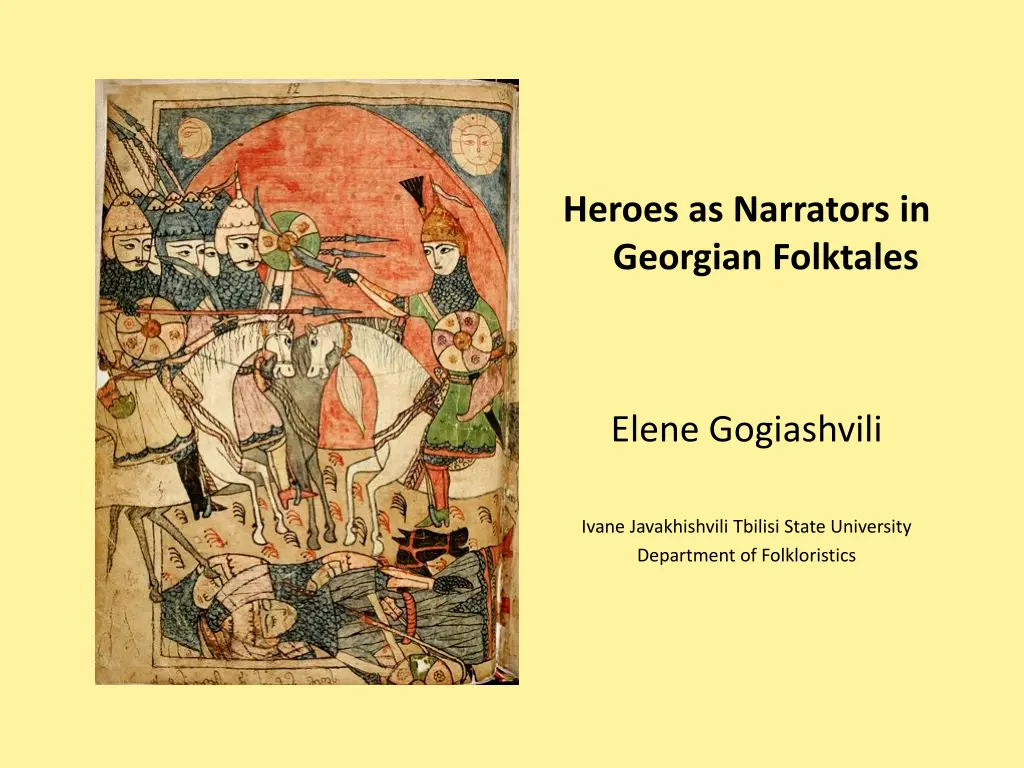
Heroes as Narrators in Georgian Folktales
Explore the captivating tales of mythological, epic, and literary heroes in Georgian folklore as narrated by Elene Gogiashvili and Ivane Javakhishvili from Tbilisi State University's Department of Folkloristics. Dive into the adventures of Amiran, Tariel, and Rostom, as they recount their extraordinary encounters and experiences. Discover the rich tapestry of Georgian folklore intertwined with these legendary figures in a blend of history and imagination.
Download Presentation

Please find below an Image/Link to download the presentation.
The content on the website is provided AS IS for your information and personal use only. It may not be sold, licensed, or shared on other websites without obtaining consent from the author. If you encounter any issues during the download, it is possible that the publisher has removed the file from their server.
You are allowed to download the files provided on this website for personal or commercial use, subject to the condition that they are used lawfully. All files are the property of their respective owners.
The content on the website is provided AS IS for your information and personal use only. It may not be sold, licensed, or shared on other websites without obtaining consent from the author.
E N D
Presentation Transcript
Heroes as Narrators in Georgian Folktales Elene Gogiashvili Ivane Javakhishvili Tbilisi State University Department of Folkloristics
Mythological, epic and literary heroes in one folktale Amiran Tariel Rostom
Amiran - a mythological hero, chained in a cave in the mountains of the Caucasus.
Tariel - a protagonist of the poem The Knight in the Panthers Skin by Shota Rustaveli Shota Rustaveli fresco in the Monastery of the Cross in Jerusalem 13th century
Rostom - a character of the poem Shahnameh by Firdawsi, Persian writer of the eleventh century. Georgian manuscript of Shahnameh 17th century
Archival sourses Folklore Archive of Shota Rustaveli Institute of Georgian Literature Archive of the State Folklore Centre of Georgia
Variants recorded by Petre Umikashvili, a Georgian folklorist, in 1871 (Shota Rustaveli Institute of Georgian Literature). recorded by M. Khutsishvili in 1937 (Archive of the State Folklore Centre of Georgia).
Once the three heroes - Amiran, Tariel and Rostom met. Let us tell our stories! Which of them is the most marvellous? they said. First, Rostom told his adventure: One night I met a man in the field. He was as small as a thumb. I asked him: Where are you going? He answered: I am going to steal the herd of horses which belong to Rostom, and where are you going? I told him that I was going to steal the herd of horses which belonged to Rostom too. We approached the herd. The marvellous man swooped over the wall. He threw horses upon horses. I was astonished. Who are you? I asked him, Are you afraid of anything? The marvellous man told me: I am afraid only of a scream of Rostom and a neigh of his horse. When I heard this, I screamed. My horse neighed and, the small man disappeared. That was the most marvellous story in my life.
Then Tariel told this story: Once, after a war, eleven knights and myself were lost in the forest. Suddenly we saw an enormous skull. We went inside it and spent the night in there. Next morning we wanted to know whose skull that was. We wished to see that creature alive. We started to pray. After a while, the skull began to grow. Finally, the man woke up. He was as big as a giant. Who are you? How could you breathe new life into me? asked the giant. Then he saw the fields and mountains around and became sad: Everything is changed. Everything is a colour of blood. This world has become sinful.
He asked us to show him the bread we ate. We gave him our bread. Blood trickled from the bread. Do you see how full of blood your world is? In my times, milk used to trickle from bread. I would not like to live in your evil world. Please pray to return me to my previous condition! We prayed and the giant turned into the skull again. That was my story.
Finally, Amiran told his story: Once I saw a red river. I went to its mouth in the mountain and saw a black giant sitting on the hill. He was holding his spear in front of him. When he dozed, he cut his forehead on the spear and bled profusely. That s why the water in the river was red. I asked the black giant what was going on. He answered: I am waiting for a white giant. He is accompanying a beautiful woman. I want to steal the woman from him. When they approach us, the beauty of the woman will brighten up the world. Please wake me up and wait while I am wrestling with the white giant. If you see that the white giant is stronger than me, then scream. The white giant will be scared and run away. The giant fell asleep.
Finally, the white giant and the beautiful woman arrived. I woke the black giant and they started to fight. The black giant beat the white giant, but he got wounded and died too. The woman asked me to bury the dead giants. I brought a chart. The woman put the corpses on the chart. One giant s leg dropped from the chart. The woman asked me to set the leg right. I tried but I could not even raise the leg of the giant. The woman became angry and left me. That was my story. The three knights swore eternal friendship to each other.
The Tale of the Three Knights in a frame Amiran, Tariel and Rostom meet each other and tell their stories. Amiran s tale Tariel s tale Rostom s tale Inserted story in the Tariel s tale The three knights swear eternal friendship to each other.
The stories have folkloric origins related with the motifs: Mot. D1311.8: Divination by head Mot. D 1610.5: Speaking head Mot. F 531.1.0.1.1: Beautiful giantess Mot. F 531: A person of enormous size Mot. F 531.2.3: Giants skull holds a man seated Mot. F 531.6.8.3.3: Giants wrestle with each other Mot. F 302.4: Man obtains power over fairy mistress
Amiran is a son of the pagan goddess, but his godfather is Jesus Christ. Illustration by Tamar Khoshtaria
Tariel distinguished by his wild character as symbolized by his wearing the panther s skin, an image of a passionate person and true love. The history of the poem makes it worthy of perusal, for it has been in a unique manner the book of a nation for seven hundred years; down to our own days the young people learned it by heart; every woman was expected to know every word of it, and on her marriage to carry a copy of it to her new home. Marjory Wardrop, the first English translator of The Knight in the Panther s Skin Illustration by Irakli Toidze
Rostom a character who fought and killed his own son Sohrab in the battle. The stories of Rostam and Sohrab became part of Georgian folklore. The horse of Rostom, called Raksh, became a universal name of a fairy- tale winged horse in Georgian lexica ( Rashi ).
In ethnographic reality and everyday Georgian vocabulary Tariel is a synonym of a handsome and powerful young man. Amiran and Rostom mean strong and well- built men.


